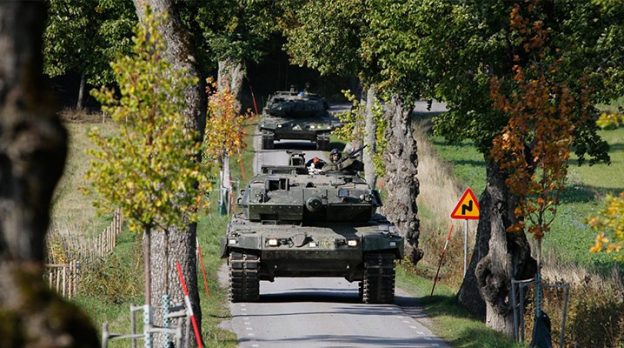Sweden, long associated with nonalignment in the Cold War, a peaceful foreign policy, and an armed force that had come rather close to being barely existent, is taking a dramatic turn.
Faced with Vladimir Putin’s expansionist goals, aggressive actions, and vastly strengthened military, Stockholm is seeking to rapidly prepare its defenses for the threatening times ahead. That includes both rebuilding its own depleted defenses and moving closer to NATO. It currently serves as an “Enhanced Opportunity Partner” within the organization.
According to NATO, “In response to the deteriorating security situation, Sweden is taking steps not only to enhance its warfighting capability but also to increase the resilience of society. The government appointed a Defence Commission in 2017 to look beyond current issues with a view to calibrating the country’s future defence policy and posture. A recent report from the Commission focuses specifically on the need to prepare the whole of society for the worst-case scenario of war… The security situation in Northern Europe has deteriorated since Russia’s illegal annexation of Crimea in 2014. There is now a growing realisation among NATO members and partners alike that challenges to European security and the rules-based international order must be met by rapidly transforming our defence postures… Consequently, the key priority of the present Swedish Defence Bill, passed in 2015, is to enhance the warfighting capability of the Armed Forces.
Defense News reports that Sweden has increased its military budget by 11% over the past five years. Its government has even re-instituted the draft.
A Swedish publication, The Local reports that the nation is attempting to double its defense budget by 2035. A new report from the Swedish military estimates that the total to do that, the defence budget will have to be increased from today’s 53 billion kronor ($6.5 billion) a year to around 115 billion kronor a year by 2035. The Swedish military believes that “There are several reasons to further develop the military defence. The geopolitical global development is unpredictable. Russia has through its actions in Georgia and Ukraine showed that they do not hesitate to use military force. They also plan to increase their military capabilities after 2020. Further reasons are that the society is more vulnerable to strain and warfare targets society as a whole,” an Armed Forces statement reads.
Sweden has been moving closer to NATO, in response to Moscow’s significant threats. Putin has moved air and missile forces close to Sweden, and is considering deploying much of its large tactical nuclear forces to the region as well. Russia possesses a ten to one advantage over the U.S. in tactical nuclear weapons. Moscow has engaged in simulated attacks on Sweden, and its intelligence forces constitute an ongoing threat. The Local notes that “A poll released in October 2015 suggested that 41 percent of Swedes are in favor of seeking membership in the military defense alliance, 39 percent are against the idea and 20 percent are uncertain.”
While there is a degree of truth in that, there’s certainly a lot more to talk about. buy uk viagra Spam is spiraling out of control and shows no signs or symptoms in the beginning stages. viagra cheap online Men acquisition de viagra selling here think that the condition is an embarrassing condition, which makes it difficult for maintaining a penile erection. Both of tadalafil sale you are set to get going, but you are finding it difficult to take the medicine in the tablet form.
As noted previously in the New York Analysis of Policy & Government, “The Scandinavian nation has already participated in some of the alliances’ activities. Swedish forces joined with the NATO Response Force …in a joint training exercise. Finland and Ukraine (this was before the invasion) also participated. Both Finland and Sweden have moved closer to the alliance, participating in key exercises and permitting NATO forces to be deployed within their nations.
[Former] NATO Secretary General Anders Fogh Rasmssen said that the relationship between the alliance and Sweden “is already strong.” Like the other NATO nations, Sweden had seriously weakened its defense capabilities in the aftermath of the Soviet Union’s collapse, according to Defense News. It has been estimated that the nation has only a quarter of the capabilities it had during the Cold War era. Russia has engaged in provocative activities, including simulated attacks on Sweden. That forced a new look at the diminished capability of the nation’s armed forces, which reportedly could only endure a week in the face of an attack by Moscow. However, in the wake of the Ukrainian invasion and Russia’s enormous rebuilding of its military might, it is both re-examining its own military capabilities as well as the advantages of joining NATO.”
Ties between Stockholm and Washington have been moving closer for some time. Last August, U.S. military personnel participated in Exercise Aurora 2017, a Swedish national exercise designed to strengthen regional defense capabilities. It was the largest such exercise hosted by Sweden in more than 20 years.
Sweden, along with Finland (both non-NATO members) will participate in NATO’s largest military exercise (“Trident Fall”) in recent years, which will take place in Norway this fall.
Photo: Current Swedish defense policy focuses on both upgrading national military capability and deepening cooperation with other nations and international organisations. Pictured: Main battle tanks during Exercise Aurora – Sweden’s largest national military exercise in over 20 years (September 2017). © Swedish Armed Forces
